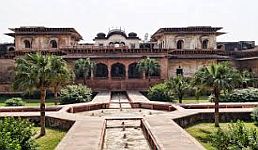Deeg Fort which encompasses the famous Deeg Palace was built by Maharaja Suraj Mal in 1730. Capital of the Jat rulers and located 32 km from Bharatpur, the Deeg Palace was built as a summer mansion and was heavily inspired by Mughal architecture. Being constantly under threat by the Mughals, Maharaja Suraj Mal built a large quadrangle shaped fortress around Deeg Palace to protect it from the invaders.
The resplendent palace has striking features such as the beautiful arches, swing, pillars, corridors, ornamented gates, marble jaalis, the watch tower, elegant courtyards, scenic gardens, lake and well manicured flowerbeds and shrubs. The entrance of the palace, Singh Pol is named after the lion sculpted on the archway. The design of the garden is believed to be inspired by the Mughal Charbagh which four gardens interspersed by a walkway. The fort is decked with 900 fountains which were supplied with water from two big water tanks - Rup Sagar and Gopal Sagar flanked on either side of the palace with the aim to bring down the temperature during the summers. Rajasthan has more history than the entire country put together – it is the realm of erstwhile Maharajas and their lavish palaces and majestic forts.
The fort is divided into several mansions namely:
Gopal Bhavan - this is one of the finest mansion in Deeg Fort. Its reflection in the surrounding water gives it a glistening ambience. The Bhavan has a remarkably impressive interior with a palanquin roof and an unobstructive view of the charbagh. Apart from this, the Bhawan also has two small edifices called Sawan and Bhadon in the north and south side respectively. The king is believed to have resided in this bhavan.
Suraj Bhavan – One of the beautiful mansion in the palace complex, it was built by Surajmal. It has a verandah with five arched opening and corner rooms on each side. The bhavan is built with buff sandstone on which white marble was encased subsequently.
Kisan Bhavan - Situated on the southeast side of the palace complex, this meeting hall is a well-decorated mansion which has a paneled facade that is broken by five large central archways adorned with a series of fountains on the terrace.
Hardev Bhawan - The Hardev Bhawan lies behind Suraj Bhawan and has a vast garden on the front which is laid out out in Mughal charbagh style.
Keshav Bhavan – the monsoon pavilion, it is the the most fascinating bhavan of Deeg Palace and stands next to the Rup Sagar. An arcade runs around the interior of the pavilion over the fountains and a canal, the walls of which are pierced with hundreds of minute water jets. The fountain spray and the jets create a monsoon-like ambience that is enhanced by a unique technique that produces thunder-like sound all around the pavilion. Hundreds of metal balls placed strategically on the channel surrounding the roof are set rolling with the water pressure which results in a thunderous effect.
Nand Bhawan - Located on the north side of the central garden, this is a large oblong hall that is raised on a terrace and enclosed by a garden of seven openings.
Purana Mahal - Built by Badan Singh, Purana Mahal is planned as a spacious rectangle with an interior consisting of two separate courts. It continues the tradition of a typical palace. It has impressive exterior. The arches are both of engrailed and pointed types.The royal abodes are planned along the periphery of the central garden and flanked by two reservoirs i.e. the Rup Sagar on the east and the Gopal Sagar on the west.
The best time to visit Deeg is between September to March as it faces harsh summers with temperatures rising to nearly 50 degrees.
Location
Deeg Palace, Deeg, Rajasthan 321203
https://www.google.co.in/maps/place/Jal+Mahal+Deeg/@27.4719543,77.3224472,17z/data=!3m1!4b1!4m5!3m4!1s0x39730451c50b35af:0xc9f1b2d4628b27eb!8m2!3d27.4719543!4d77.3246359
Highlights
- It is a symphonic blend of Rajput and Mughal architecture.
- A magnificent palace, it is surrounded by the fortress and a deep moat to keep invaders at bay.
- The palace was constructed out of red stone and marble.
- The boat shaped edifice Sawan and Bhadon is a craftsmanship marvel through which water runs from a chute through each of the structures and falls onto a verandah.
Recommended For
A perfect weekend getaway and opportunity to explore of the Rajasthan’s royal palace and heritage
How to get to Deeg
Air: The nearest airport is the Indira Gandhi International Airport, Delhi and Kheria Airport, Agra. From there a cab can be hired to reach Deeg.
Train: The nearest station is Bharatpur station which is well connected with major cities of India. From there a cab can hired to reach Deeg directly.
Road: Numerous private and state buses from Bharatpur go to Deeg. You can also hire private car and cab to reach deeg.
Interesting Facts About Deeg
- The Deeg Palace is also known as ‘Jal Mahal’ meaning the water palace
- Some of the materials used to construct the palace, antiques and a huge cannon were brought from Red Fort in Agra when Maharaj Suraj Mal attacked and looted it after the battle.
- The ideology behind 900 fountains was to lower the temperature of the fort










